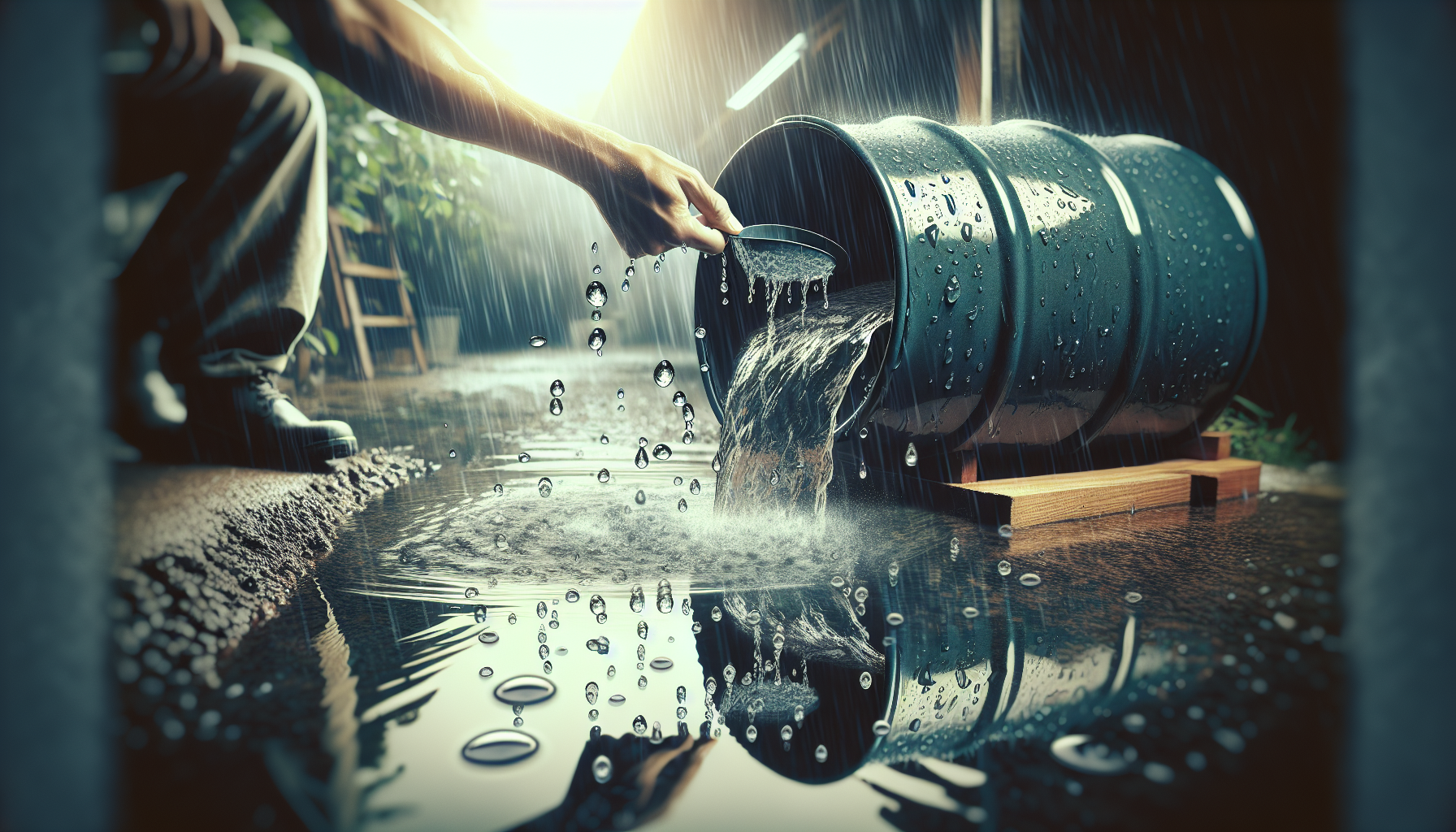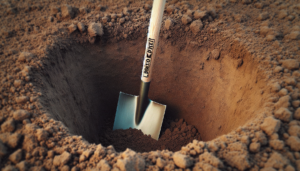
In this article, you will explore the steps involved in creating a rainwater harvesting system specifically designed for emergency water needs. As climate change continues to impact weather patterns and natural disasters become more frequent, having access to a reliable and sustainable water source during emergencies is crucial. By implementing a rainwater harvesting system, you can ensure that you have access to clean and accessible water even when traditional sources are disrupted. Let’s delve into the details of how you can create such a system and be prepared for any emergency water situation.
Choosing a Collection Method
Identify the suitable collection method
When choosing a collection method for rainwater harvesting, it is important to consider the available options and identify the most suitable method for your specific needs. Common collection methods include rooftop harvesting, surface water collection, and underground cisterns. Each method has its advantages and disadvantages, so it’s crucial to evaluate factors such as space availability, local regulations, and your water requirements before making a decision.
Consider the available space
The available space plays a significant role in determining the collection method for your rainwater harvesting system. Rooftop harvesting is a popular choice for many homeowners, as it utilizes the surface area of rooftops for collection. However, if you have limited roof space, you may need to explore other options such as surface water collection or underground cisterns. Consider the size and layout of your property to determine the most suitable collection method that maximizes the available space.
Assess the average rainfall in your area
To ensure the effectiveness of your rainwater harvesting system, it is essential to assess the average rainfall in your area. This information will help you calculate the potential water yield and determine if rainwater harvesting is a viable option. Climate data and historical rainfall patterns can be obtained from local weather stations or online resources. Additionally, consulting with a rainwater harvesting professional can provide valuable insights into the local rainfall patterns and help you make an informed decision.
Evaluate the quality of rainwater
Before implementing a rainwater harvesting system, it is crucial to evaluate the quality of rainwater in your area. Factors such as air pollution, surrounding vegetation, and roof material can affect the quality of collected rainwater. It is advisable to conduct water quality tests to identify any contaminants or impurities that may exist in the rainwater. Understanding the quality of rainwater will help you determine if additional treatment or filtration is necessary to ensure its usability for various purposes.
Designing the Collection System
Calculate the water requirement
To determine the size and capacity of your rainwater harvesting system, it is important to calculate your water requirements. Consider the intended uses of the harvested rainwater, such as landscape irrigation, toilet flushing, or laundry, and estimate the amount of water needed for each application. This calculation will help you design a collection system that meets your specific water needs.
Determine the size of collection area
The size of the collection area, usually the rooftop, is an important factor in designing an efficient rainwater harvesting system. The larger the collection area, the more water can be harvested during rainfall events. Calculate the available collection area by measuring the square footage of your roof or any other surface you plan to use for rainwater collection. This information will enable you to determine the optimal storage capacity and select the appropriate collection components.
Select a suitable catchment surface
Choosing a suitable catchment surface is vital for effective rainwater collection. The catchment surface should be clean, smooth, and non-toxic to prevent any contamination of the collected rainwater. Common catchment surfaces include metal, asphalt shingles, or tile roofs, as they are generally safe and provide efficient water runoff. Avoid using materials such as lead or asbestos, as they can contaminate the rainwater and pose health risks.
Include guttering and downpipes
Guttering and downpipes are essential components of a rainwater harvesting system as they facilitate the collection and transportation of rainwater from the catchment surface to storage tanks or reservoirs. Properly installed guttering and downpipes ensure efficient water flow, preventing water loss and the potential for damage to your property. Regular maintenance, including cleaning debris from the gutters and checking for leaks, is crucial to ensure optimal performance.
Selecting Storage Options
Choose the right type of storage tank
Selecting the right type of storage tank is crucial in ensuring the longevity and functionality of your rainwater harvesting system. Common types of storage tanks include polyethylene (plastic), fiberglass, concrete, and steel tanks. Each type has its unique characteristics, such as durability, cost, and maintenance requirements. Consider factors such as available space, budget, and local regulations when choosing the most appropriate storage tank for your needs.
Consider the storage capacity needed
Determining the storage capacity needed for your rainwater harvesting system depends on factors such as average rainfall, water requirements, and available space. Calculate the water demand for your intended uses and consider any additional factors such as dry spells or emergencies. It is advisable to have a storage capacity that can sustain your needs for extended periods without relying solely on rainwater. This ensures you have an ample water supply even during droughts or system maintenance.
Evaluate the location for the storage tank
The location of the storage tank is another crucial aspect to consider in the design of your rainwater harvesting system. The tank should be situated in a well-drained area that can support its weight when filled with water. Keep in mind any local regulations or restrictions regarding the placement of storage tanks. Additionally, consider accessibility for maintenance and the ease of connecting the tank to the distribution system.
Ensure proper maintenance and protection
Regular maintenance is essential for the longevity and efficiency of your rainwater storage tank. Ensure that the tank is inspected for leaks or damage and cleaned periodically to prevent the buildup of sediment or biological growth. Installing protective measures such as screens or filters at the tank inlet will help prevent debris or insects from entering the system. Proper maintenance and protection measures will ensure the stored rainwater remains safe and usable throughout its intended lifespan.
Installing a Filtration System
Understand the importance of filtration
Filtration plays a critical role in rainwater harvesting systems as it helps remove impurities and contaminants from collected rainwater. Proper filtration enhances the quality of stored rainwater, making it suitable for various applications such as drinking, cooking, or bathing. Without filtration, the collected rainwater may contain debris, sediment, or microorganisms that can pose health risks or damage plumbing fixtures and appliances.
Choose an appropriate filtration method
Choosing the appropriate filtration method depends on the intended uses of the rainwater and the quality of the collected water. Common filtration methods include sediment filters, activated carbon filters, and UV sterilizers. Sediment filters remove larger particles, while activated carbon filters and UV sterilizers help eliminate smaller impurities and microorganisms. Consult with a rainwater harvesting professional to determine the most suitable filtration method for your specific needs.
Install a pre-filtration system
A pre-filtration system is typically installed before the rainwater enters the storage tank. This system helps remove larger debris, leaves, or insects that may be present in the collected rainwater. Pre-filtration can be achieved through the use of filters, screens, or settling chambers. Properly installed pre-filtration systems enhance the efficiency of subsequent filtration processes and minimize the risk of clogging or contamination of the storage tank.
Include a post-filtration process
A post-filtration process is an additional step to ensure the quality of the rainwater before it is distributed for use. This step involves the use of filters or other treatment methods to further remove any remaining impurities or microorganisms. Post-filtration can help improve the taste, odor, and clarity of the water, ensuring it meets the desired quality standards. Consider the specific water quality requirements for your intended uses when selecting and implementing the post-filtration process.
Establishing a Distribution System
Determine the water distribution needs
Before establishing a distribution system for your rainwater harvesting system, it is essential to determine your water distribution needs. Assess the intended uses of the collected rainwater, such as irrigation, toilet flushing, or domestic water supply, and calculate the required flow rate and pressure for each application. This information will help you select the appropriate distribution components and design an efficient system for delivering the rainwater to its designated areas.
Install a pump or gravity-driven system
The method of water distribution will depend on factors such as the elevation of the storage tank compared to the desired distribution points and the required flow rate. If the distribution points are located at a higher elevation or require a significant flow rate, a pump system may be necessary to deliver the rainwater efficiently. Alternatively, in situations where gravity can provide adequate flow, a gravity-driven system can be implemented. Consult with a rainwater harvesting professional to determine the most suitable distribution system for your specific needs.
Consider the use of storage taps or faucets
To enable easy access to the harvested rainwater, consider installing storage taps or faucets in convenient locations throughout your property. These taps or faucets can be connected to the distribution piping system and strategically placed near areas where water is needed, such as gardens, outdoor cleaning stations, or laundry rooms. This allows for easy use of the rainwater without the need for additional plumbing connections.
Implement a plumbing system
Implementing a plumbing system for your rainwater harvesting system involves connecting the storage tank to the distribution points throughout your property. This includes laying pipes, installing valves, and connecting fixtures. It is crucial to ensure that the plumbing system is properly designed and installed to minimize the risk of leaks or pressure issues. Compliance with local plumbing codes and regulations is necessary to ensure a safe and efficient distribution system.
Ensuring Water Purity
Understand the potential contaminants
Understanding the potential contaminants that can affect the quality of harvested rainwater is vital for maintaining water purity. Common contaminants include sediment, organic matter, microorganisms, and chemical pollutants. These contaminants can enter the rainwater system through various sources such as the catchment surface, debris, or atmospheric pollutants. Awareness of potential contaminants allows for appropriate filtration, treatment, and maintenance measures to be implemented to ensure the purity of the stored rainwater.
Test the water quality regularly
Regular testing of the water quality is essential to monitor the effectiveness of your rainwater harvesting system and ensure the safety of the stored water. Water quality tests should include parameters such as pH, turbidity, bacterial presence, and chemical composition. These tests can be conducted using commercially available kits or by sending samples to a certified laboratory. Regular testing will help identify any changes or issues with the water quality and allow for appropriate corrective measures to be taken.
Implement proper disinfection methods
Disinfection is a crucial step in ensuring the microbiological safety of harvested rainwater. Various disinfection methods can be used, including chlorination, UV sterilization, or ozonation. The choice of disinfection method will depend on factors such as the intended uses of the water and the level of microbiological contamination present. Consult with a water treatment professional to determine the most suitable disinfection method for your specific needs and ensure effective disinfection of the stored rainwater.
Consider additional treatment options
Depending on the specific water quality requirements and potential contaminants in your area, additional treatment options may be necessary to ensure water purity. These can include filtration technologies such as reverse osmosis or activated carbon filters, as well as specialized treatment methods for removing specific contaminants such as heavy metals or chemical pollutants. Assess the water quality test results and consult with water treatment experts to identify any additional treatment options that may be beneficial for your rainwater harvesting system.
Maintaining the System
Perform routine inspections
Routine inspections are essential to ensure the proper functioning and longevity of your rainwater harvesting system. Regularly inspect all components, including storage tanks, catchment surfaces, gutters, downpipes, and filtration systems, for any signs of damage, corrosion, or dysfunction. This will allow for timely repairs or replacements to be made, preventing further issues and prolonging the lifespan of the system. Develop a maintenance schedule and adhere to it to keep your rainwater harvesting system in optimal condition.
Clean and maintain the storage tank
Regular cleaning and maintenance of the storage tank are crucial to prevent the buildup of sediment, algae, or other contaminants that can affect water quality. Inspect the inside of the tank for any debris or sediments and clean it thoroughly as recommended by the tank manufacturer. Additionally, ensure that the tank is properly sealed and secured to prevent any unauthorized access or potential contamination. Regular maintenance and cleaning of the storage tank will help ensure the safety and usability of the stored rainwater.
Check and repair any leaks
Leaks in the rainwater harvesting system can result in water loss, reduced system efficiency, or potential damage to your property. Regularly check for any leaks, including in the gutters, downpipes, storage tank connections, or distribution piping. Repair any identified leaks promptly to prevent further issues. Regular maintenance and inspections will help minimize the risk of leaks and ensure the optimal performance of your rainwater harvesting system.
Replace filters as needed
Filters play a vital role in maintaining water quality in your rainwater harvesting system. Over time, filters can become clogged or lose their effectiveness, resulting in reduced filtration capacity. Regularly inspect the filters and replace them as recommended by the manufacturer or based on water quality test results. Properly functioning filters are essential for ensuring the purity of the stored rainwater and preventing damage to downstream components or appliances.
Complying with Local Regulations
Research local laws and regulations
Compliance with local laws and regulations is crucial when designing and implementing a rainwater harvesting system. Research the applicable laws and regulations in your area to ensure that your system meets all requirements. Key areas to consider may include the permitted uses of rainwater, storage tank placement, plumbing codes, or any required permits. Failure to comply with local regulations can result in penalties or the need for costly modifications to your rainwater harvesting system.
Obtain necessary permits and approvals
Before installing a rainwater harvesting system, it is important to obtain any necessary permits and approvals from local authorities. The requirements for permits may vary depending on your location and the size or complexity of your system. Consult with the relevant authorities early in the design phase to ensure you have all the necessary permits in place before commencing installation. This will help avoid potential legal issues and ensure that your rainwater harvesting system is in compliance with local regulations.
Ensure compliance with building codes
In addition to obtaining permits and approvals, it is important to ensure compliance with building codes when installing a rainwater harvesting system. Building codes dictate certain requirements for structural integrity, fire safety, plumbing, and electrical connections. Consult with local building authorities or engage a professional to ensure that your system design adheres to the applicable building codes. Compliance with building codes helps ensure the safety and efficiency of your rainwater harvesting system.
Connect with local water authorities
Connecting with local water authorities can provide valuable guidance and support throughout the design and implementation of your rainwater harvesting system. They can provide information on local regulations, best practices, and any incentives or rebates that may be available for rainwater harvesting systems. Additionally, local water authorities can offer advice on water quality testing requirements and ensure that your rainwater harvesting system complements existing water management initiatives in your area.
Preparing for Emergency Situations
Create an emergency plan
Preparing for emergency situations is a crucial aspect of rainwater harvesting system design. Create an emergency plan that outlines the steps to be taken in case of a water supply disruption or other emergencies. This plan should include procedures for activating backup water supplies, managing water usage, and ensuring the continuity of essential water-dependent activities. Share this plan with family members, housemates, or relevant stakeholders to ensure everyone is aware of the emergency protocols.
Establish a backup water supply
While rainwater harvesting provides a sustainable water source, it is essential to have a backup water supply in case of emergencies or extended periods of low rainfall. Backup options may include connecting to a municipal water supply, maintaining a well or borehole, or storing additional water from external sources. The backup water supply should be properly stored, treated, and monitored to ensure its availability and safety when needed.
Educate yourself and your family on usage
Proper education on the usage of rainwater and its limitations is essential for the efficient and responsible use of the harvested water. Educate yourself and your family members on the intended uses of the rainwater, including any restrictions or guidelines that need to be followed. Teach water conservation practices such as minimizing wastage, using efficient fixtures and appliances, and timing irrigation appropriately. This knowledge will help ensure the sustainability and longevity of your rainwater harvesting system.
Consider water purification options
In emergency situations where the quality of the collected rainwater may be compromised, additional water purification options should be considered. Water purification methods such as boiling, chemical treatment, or portable water filters can be used to improve the safety of the water before consumption. Familiarize yourself with these purification methods and have appropriate supplies or equipment readily available in case of emergencies.
Scaling Up for Increased Capacity
Evaluate future water requirements
If you anticipate an increase in water requirements in the future, it is important to evaluate the capacity of your existing rainwater harvesting system. Factors such as changes in household size, additional water-dependent activities, or drought conditions may necessitate scaling up your system. Consider the storage capacity, collection area, distribution capacity, and filtration capabilities of your system and assess if any upgrades or modifications are needed to meet future water demands.
Expand the collection and storage infrastructure
Increasing the collection and storage infrastructure is a viable option for scaling up your rainwater harvesting system. This may involve expanding the collection area by increasing the size of the catchment surface or adding additional catchment areas. Similarly, expanding the storage capacity through the installation of additional storage tanks or upgrading to larger tanks will enable more water to be harvested and stored. Ensure that any expansion or modifications are in compliance with local regulations and consider consulting with a rainwater harvesting professional for expert guidance.
Upgrade filtration and distribution systems
As your water requirements increase, it may be necessary to upgrade the filtration and distribution systems of your rainwater harvesting system. Upgrading the filtration system can enhance the water quality and ensure that it meets the demand for various uses. Similarly, upgrading the distribution system, such as installing additional pumps or optimizing the plumbing layout, can improve the efficiency and reliability of water distribution. Evaluate the current capabilities of your system and consider the necessary upgrades to accommodate increased capacity.
Consider commercial-scale rainwater harvesting
For significant increases in water requirements or commercial applications, it may be necessary to consider commercial-scale rainwater harvesting systems. These systems are specifically designed to cater to large-scale water demands and can include multiple catchment surfaces, extensive storage capacity, and advanced filtration and distribution systems. Engaging with rainwater harvesting professionals experienced in commercial-scale projects can help ensure the successful implementation of the system and compliance with regulatory requirements.
In conclusion, creating a rainwater harvesting system involves various considerations and steps. From choosing the appropriate collection method to ensuring water purity and complying with local regulations, each aspect plays a crucial role in the design and implementation of an efficient and sustainable system. Regular maintenance, proper filtration, and education on water usage are essential for the long-term success of the system. By following these guidelines and engaging with professionals when needed, you can create a reliable rainwater harvesting system that provides emergency water and contributes to sustainable water management.







